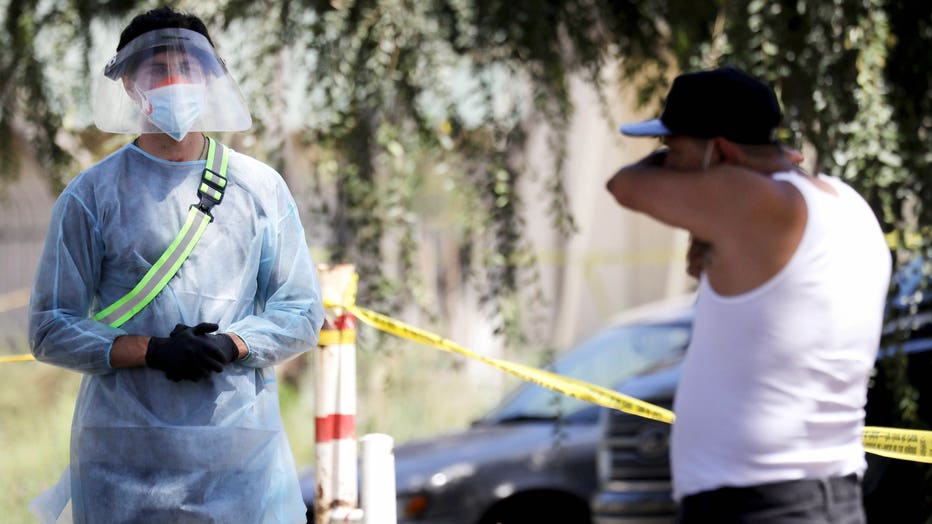Could your symptoms be COVID-19? The signs range from mild to severe
As the world continues its battle the novel coronavirus, any subtle cough or sudden scratch in the throat may lead one to suspect the worst.
Health officials say that becoming infected with COVID-19 can lead to a wide variety of symptoms, ranging from mild to severe. The most common symptoms are fever, a dry cough, shortness of breath and fatigue.
But as the months-old virus continues its spread, additional symptoms are being identified — and they can be unpredictable.

A COVID-19 testing associate dressed in personal protective equipment watches a man cough into his arm as part of a self-administered test at a testing center at Lincoln Park amid the coronavirus pandemic on July 7, 2020 in Los Angeles, California. (
More common symptoms
The U.S. Centers for Disease Control and Prevention highlights 11 different symptoms of COVID-19 on its website:
Fever or chills
Cough
Shortness of breath or difficulty breathing
Fatigue
Muscle or body aches
Headache
New loss of taste or smell
Sore throat
Congestion or runny nose
Nausea or vomiting
Diarrhea
The agency notes that the list does not include all possible symptoms of COVID-19, and said that it would continue to update the list as more becomes known about the virus.
RELATED: CoronavirusNOW.com, FOX launches national hub for COVID-19 news and updates
Compared with the flu or a common cold, the CDC says COVID-19 symptoms may appear more slowly — between two and 14 days after exposure. A recent report by the agency acknowledged that symptoms can last for two to three weeks after a positive test.
Older adults and those with underlying medical conditions, such as heart or lung disease or diabetes, seem to be at higher risk for developing more serious complications from the virus, according to the CDC.
New, more unusual symptoms
Skin problems or “COVID toes,” where the fingers and toes become red, sore, itchy and/or swollen, has been identified as a possible early symptom of COVID-19.
Eye problems such as enlarged, red blood vessels, swollen eyelids, excessive watering and increased discharge have also been highlighted as potential early signs of the virus, according to the Mayo Clinic. Doctors have reported cases of pink eye, an extremely contagious infection known as conjunctivitis, in a small number of cases.
In older people, especially those with severe infections, COVID-19 has been known to cause confusion.
RELATED: Beyond fever and shortness of breath, experts say COVID-19 symptoms can appear in unusual ways
Emergency warning signs
Constant trouble breathing, persistent chest pain or pressure, inability to stay awake or blue-tinged lips or face could all be signs of an emergency, according to the CDC. Anyone experiencing such symptoms should seek immediate emergency medical care.
Those with no symptoms
Some people never feel sick or notice any symptoms, even though they’re infected and can still transmit the virus to others.
A recent study in South Korea found that asymptomatic people who are infected with COVID-19 carry similar levels of the virus in their body as those with symptoms — and for almost as long.
If you think you have COVID-19
The CDC advises individuals who think they may have been exposed to COVID-19 to contact a doctor. Mild symptoms, like a slight cough or a mild rash, may not require a visit to the emergency room.
Health experts recommend self-isolating, including staying away from other people and pets in the home. The CDC also suggests using a separate bathroom, if possible.
Individuals with COVID-19 should monitor symptoms to see if they become more severe. Call ahead before visiting the doctor, and the CDC says everyone with the virus should wear a mask if they must be around other people or animals — even at home.
RELATED: CDC says most people with COVID-19 should isolate for 10 days, rather than 14
This story was reported from Cincinnati.



